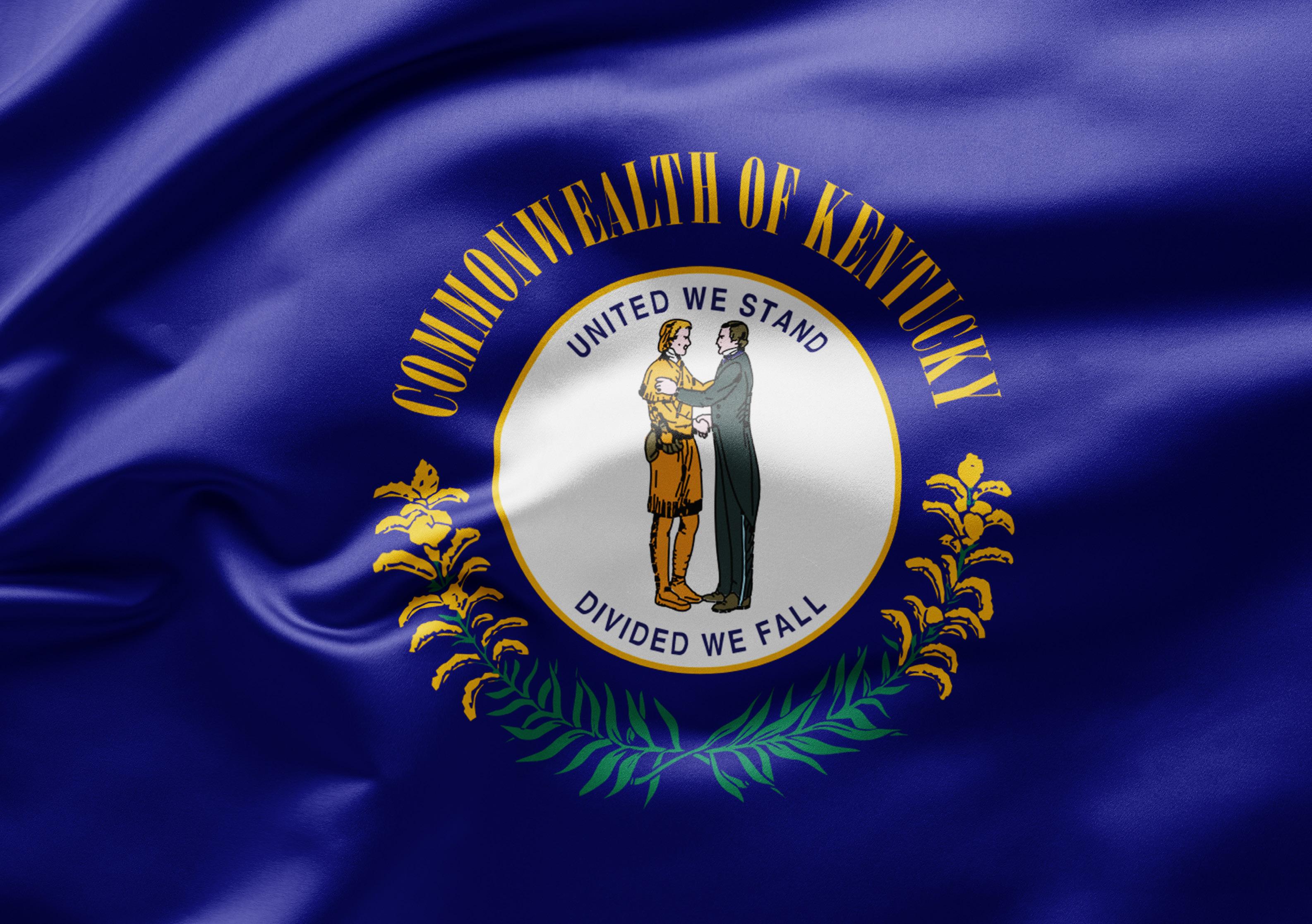

We do business the way
K E N T U C K Y
B A N K S do business. Western Kentucky


a c B o d e n h e i m e r Eastern Kentucky




We do business the way
K E N T U C K Y
B A N K S do business. Western Kentucky


a c B o d e n h e i m e r Eastern Kentucky






WHO WE ARE: The KBA is a nonprofit trade association that has been providing legislative, legal, compliance and educational services to its member institutions since 1891. KBA's directors and staff work together with its members to make the financial services industry a more effective and successful place to work. The strength of the KBA is bankers unifying as an industry to speak as one voice.
WHAT WE DO: The purpose of the Kentucky Bankers Association is to provide effective advocacy for the financial services industry both in Kentucky and on a national level; to serve as a reliable and responsive source of information and education about areas of interest to the industry; and to provide a catalyst and forum for collective industry action. The KBA does this in 4 ways:
1. Government relations & industry advocacy 2. Information interchange 3. Education 4. Products and services
BANKERS
600 West Main Street, Suite 400 Louisville, Kentucky 40202
KENTUCKY BANKER is the official bi-monthly magazine of the Kentucky Bankers Association (KBA). No part of this magazine may be reproduced without express written permission from the KBA. The KBA is not responsible for opinions expressed by outside contributors published in KENTUCKY BANKER. The KBA reserves the right to publish submissions at the discretion of the KENTUCKY BANKER editorial team. For more information, or to submit an article, pictures or pass on a story lead, contact Matt Simpson, Managing Editor, at msimpson@kybanks.com
Visit us online at KYBanks.com


Nina K. Gottes Sponsorship Opportunities ngottes@kybanks.com

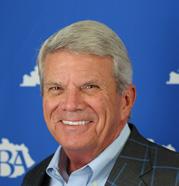
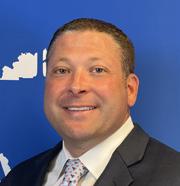







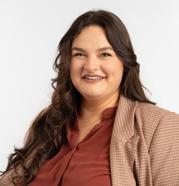
Contact Nina today about advertising and sponsorship opportunities!
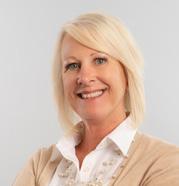


Ballard W. Cassady Jr. President & CEO bcassady@kybanks.com
Timothy A. Schenk General Counsel tschenk@kybanks.com
Miriam Cole Executive Assistant Office Manager mcole@kybanks.com
Cass Cassady Director of Events ccassady@kybanks.com
McKenzie Caldwell Staff Accountant mcaldwell@kybanks.com
John P. Cooper Legislative Solutions jcooper@kybanks.com
Amanda Cole Coordinator Bank Performance Report acole@kybanks.com
Paula Cross Education Coordinator pcross@kybanks.com
Nina K. Gottes Sponsorship Solutions ngottes@kybanks.com
Casey Guernsey Enrollment and Billing Specialist cguernsey@kybanks.com
Jamie Hampton Education Coordinator jhampton@kybanks.com
Tamuna Loladze Chief Operating Officer HOPE of the Midwest tloladze@hopeofthemidwest.
Michel Buchheister IT Specialists mbuchheister@kybanks.com






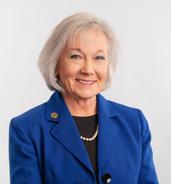






Michelle Madison IT Manager mmadison@kybanks.com
Brandon Maggard Account Representative KenBanc Insurance bmaggard@kybanks.com
Chuck Maggard President & CEO KenBanc Insurance cmaggard@kybanks.com
Lisa Mattingly Director of Sales & Service KBA Benefit Solutions lmattingly@kybanks.com
Tammy Nichols Finance Officer HOPE of the Midwest tnichols@hopeofthemidwest.com
Katie Rajchel Accounting Manager krajchel@kybanks.com
Selina O. Parrish Director of Membership sparrish@kybanks.com
Jessie Southworth Director of Education jsouthworth@kybanks.com
Jennifer Schlierf Sales Support KBA Insurance Solutions jschlierf@kybanks.com
Matt Simpson Communications Director msimpson@kybanks.com
Matthew E. Vance, CPA Chief Financial Officer mvance@kybanks.com
Billie Wade Executive Director HOPE of the Midwest bwade@hopeofthemidwest.com
Audrey Whitaker Insurance Services Coordinator awhitaker@kybanks.com
CHAIRMAN
April R. Perry, Chairman & CEO, Kentucky Farmers Bank Corporation
VICE CHAIRMAN
W. Lee Scheben, President, Heritage Bank, Inc., Burlington
TREASURER
J. Jason Hawkins, President & CEO, First United Bank & Trust Co., Madisonville
Represents Group 1
Jeff McDaniels, President & CEO Farmers Bank & Trust Company
Represents Group 2
Douglas E. Lawson, President & COO Field & Main Bank, Henderson
Represents Group 3
Logan Pichel, President & CEO Republic Bank & Trust Company
Represents Group 4
Jason T. Jones, President Morgantown Bank & Trust Co.
Represents Group 5
Don D. Jennings, CEO First Federal Savings Bank of KY
Represents Group 6
Robert Miles, President & CEO Peoples Bank of Lebanon
Represents Group 7
Lucas Shepherd, CEO First National Bank of Manchester
Represents Group 8
Lonnie Foley, President & CEO Peoples Bank of KY, Inc.
PAST CHAIRMAN
Mark Strother, President & CEO Commercial Bank of Grayson
KBA PRESIDENT & CEO
Ballard W. Cassady, Jr., President & CEO Kentucky Bankers Association
Represents Group 9
James Ayers, Regional Manager First State Bank, Inez
THRIFT REPRESENTATIVE
Glenn Meyers, Executive Vice President Citizens Federal Savings & Loan Assoc.
BANK SIZE REPRESENTATIVES
Represents Banks w/ Assets of $1B+
Michael F. Beckwith, Executive Vice President, Chief Banking Officer, German American Bank
Represents Banks w/ Assets of >$1B & at least $200M
Frank B. Wilson, President & CEO Wilson & Muir Bank & Trust Company
EDUCATION ALLIANCE
REPRESENTATIVE
Lanie W. Gardner, Community President First Southern National, Central City
KBA BENEFITS TRUST COMMITTEE REPRESENTATIVE
W. Fred Brashear, II, President & CEO Hyden Citizens Bank

January / February 2025

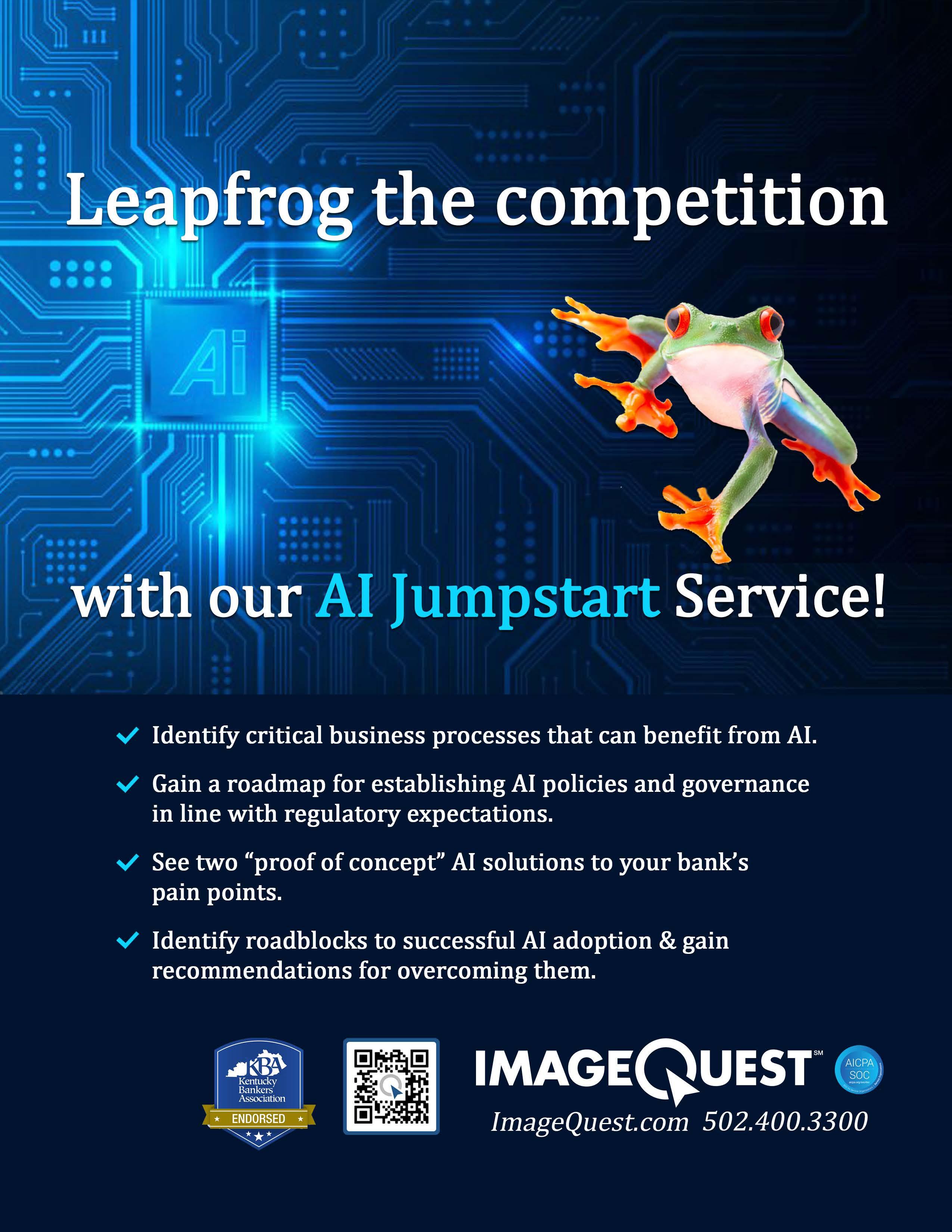
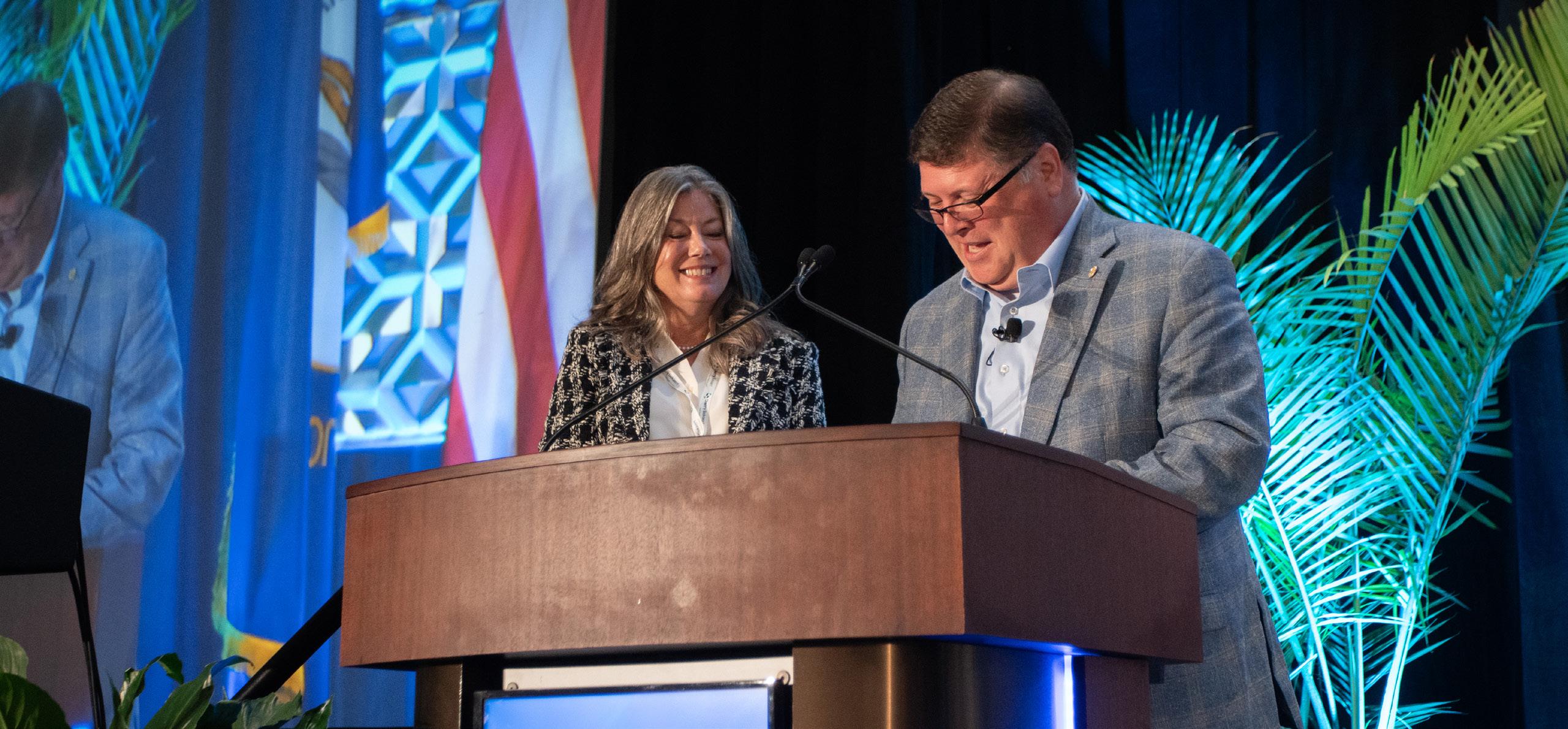
by April Perry | KBA Chairman, 2024
By the time this magazine comes out, the first session of the 2025 KY General Assembly will have ended. Over 1000 bills will be introduced, and many will be amended multiple times. Tim Schenk will have spent thousands of hours scouring the bills to understand their potential impact on Kentucky’s Banks. Ballard Cassady and John Cooper will have joined Tim for many visits to the Kentucky State Capital to speak with legislators about their bills’ unintended consequences and advocate for ones that improve our industry.
Without the dedication of Ballard, Tim, and John, our industry could be devastated by proposed laws. And I’m not just talking about laws in Kentucky. The KBA is constantly watching the federal landscape to make sure bills are passed that support our industry and others are amended or killed that harm Kentucky’s banks as well as banks across the nation. Kentucky’s banks are blessed to have the KBA advocating for us.
Although Ballard, Tim and John do the lion’s share of the work when it comes to the political landscape, they need all of us to support their efforts and advocate for our industry. How might you help? Develop a relationship with your legislators and support the KBPAC.
Legislators need to know where their constituents stand on issues, and you need to know their stance. Sign up for regular updates from your elected officials. Talk to them when you see them out and about, call them when you have a concern or want
to lend support and visit them while in session.
Give to the KBPAC. The KBPAC supports legislators, regardless of political affiliation, who support the banking industry. Our support does not ensure the vote will go our way, but it does help like-minded individuals stay in office. Once elected, it is up to us to educate our politicians on the issues that support and those that harm our industry.
The KBA sets a goal for each Kentucky Bank based on asset size. Some of our banks exceed their goal, some meet the goal, and unfortunately, some don’t contribute at all. We all benefit from the PAC, whether we contribute or not. But imagine how much stronger we would be if every bank met its goal. PAC’s cannot accept corporate donations; individuals must donate. If every Kentucky bank employee donated $10, the KBPAC would exceed its goal.
I challenge you to meet or exceed your bank’s goal this year. It is easier than you might think. Schedule a “13th board meeting” immediately following a regular board meeting, ask Ballard or Tim to speak to your group, and have your members donate to the KBPAC. Ask your employees to donate to the KBPAC and match their contribution with a donation to their favorite charity. Sign up for the KBPAC golf outing on June 23, 2025, at Heritage Hill Golf Club and have some fun while supporting the PAC. Get creative… our industry depends on your support!

I’ve lived long enough to ponder the truth of a lot of ‘old sayings.’ There’s one that comes to me a lot these days: I’d rather die standing than live on my knees.
by Ballard Cassady | KBA President & CEO
I used to hear that a lot, usually said with conviction. But is that still true for most of us? Or have we gotten more comfortable being on our knees, bowing down to “masters” like financial gain, the illusion of security, or even pressures to “go along to get along?” Over my decades of advocacy conflict, the hard truth I’ve learned is that most of us are increasingly inclined to play it safe rather than take a risk – even the risks that relate to our survival on some level.
In the shocking reversals reflected in the November election, I hope I’m seeing some recovery of the fighting spirit that made America the land of the free. I just hope those fighting to cure our nation’s fiscal cancer are able to fight longer and harder than those fighting to stop them.
My dad used to say, “A dying man’s last breath is his loudest.” (He was a doctor, but he usually wasn’t referring to his patients.) I think of that as I listen to those who “doth protest too much” at the recent discovery of government mismanagement and fraud on a scale I’d have thought beyond belief –– until the receipts started piling up. Sounds to me like ‘following the money’ in this scandal might lead quickly to those protesting the loudest.
Fixing the systems that allowed this level of waste and fraud and debt will involve some pain for most or all of us. But I fear there’s some justice in that. After all, we elected those who mismanaged and defrauded us into this debt hole; we kept re-electing those who dug it deeper with every budget vote for decades. And now, it looks to me like Americans might be in the fight of our lives, for the lives of our children and grandchildren and beyond. Which brings me back to this: I’d rather die standing than live on my knees.
Speaking of standing up, I want to pay this short tribute that some might see to be controversial at first until they stop to think about the “Long Game.” I’m hearing complaints and even criticism concerning Sen. McConnell now that he has announced his retirement. I have only this to say: if it weren’t for Sen McConnell and his dedication to the Republican Party in KY, it wouldn’t be as strong as it is today. If it weren’t for Sen McConnell we wouldn’t have a moderate Supreme Court (Merrick Garland ..really?) and what he has done for KY for all these decades is nothing short of phenomenal. I could go on and on. Trust me when I say WE WILL MISS HIM. So whenever you see him, you should say, “Thank You, Leader McConnell.”
On a much happier note, our first Directors and Officers Conference is coming up on April 13-15th. I just got off the
phone with one of our prudential regulators this morning. I was told the future of exams will involve meetings with, at the very least, the board leadership to ensure they know what they should about the bank and its management. This seems to be coming from the Silicon Valley Bank failure, where the board was notified several times of deficiencies but chose to ignore them at the CEO’s direction (according to the exit investigation).
Besides being fantastic, the speakers are at the level needed for certification. Each attendee will receive 9.5 credits in Certified Regulatory Compliance Manager (CRCM) credits and 6.5 credits in the Certified Enterprise Risk Professional (CERP) space. The certificates can then be put into your board file to show the examiners that you and your board are receiving training. This is going to be essential moving forward with bank exams.
I just got back from Asheville, NC, where I met with city officials, including Fire Department Chief Mike Cayse and the commander of the Swift Water Rescue team, Chief Wesley Rogers. Chief Rogers had just returned from eastern Kentucky, where they assisted other teams from around the country on high water rescues. These amazingly dedicated people were very complimentary of our citizens and their hospitality while here in Kentucky. Asheville is back and looking forward to welcoming our 2025 Convention in September.
Meanwhile, Kentucky has been devastated by new floods, this time in all 120 counties. Our hearts ache for the loss of life, of homes, and of all the beloved things collected over lifetimes and generations. At the same time, we feel pride in the fortitude and perseverance we’ve witnessed in the recovery – especially on hearing how that stood out to a first responder like Chief Rogers in Asheville.
The KBA Disaster Relief Fund is back in operation, and I want to thank all those who have offered aid through the fund. I want to give a special shout-out to the FHLB of Cincinnati, President Andy Howell, and our two representatives, Greg Caudill and Wade Berry. They called on Day One with a $50,000 contribution to kick off our campaign to help our bankers. There have been many others, and we will give a special “thank you” to each one, no matter what the size of the contribution.
God Bless and God speed in our recovery.




Fraud is costing banks valuable time and money—but your team can fight back.
Fraud Academy is a first-of-its-kind training program designed to equip bankers at all levels with the tools to detect, prevent, and mitigate fraud.
Led by experts from the U.S. Secret Service, law enforcement, and fraud prevention specialists, this intensive, banker centric program covers 18+ fraud risk areas, including check fraud, elder fraud, cybercrime, and prevention strategies.

by Tim Schenk | KBA General Counsel
Anyone who has read any of my prior articles probably has a pretty good sense of my feelings about the CFPB under the direction of Rohit Chopra. It probably comes as no surprise that as soon as the CFPB no longer employed Rohit Chopra, the common question hit my inbox: “What is going to happen to the CFPB?”
As someone I respect always tells me, “The smartest person in the room is the one who admits they don’t know what they don’t know.” In my attempt to be the “smartest person in the room,” I must admit: I don’t know. Nonetheless, there are several things we all know that are worth discussing.
What we do know is that there has been, and is going to be, a lot of change. On February 11th, President Trump discussed plans to close down the CFPB. President Trump said the CFPB “was set up to destroy some very good people” and that it is “very important to get rid of.” President Trump added, “It was also a waste. There was a bad group of people running it … That was a vicious group of people. They destroyed a lot of people.” In short, President Trump made his opinion of the CFPB and its prior administration very clear and followed it with direct action.
Acting Director of the CFPB and Director of the Office of
Management and Budget subsequently “closed” the agency and fired all probationary employees at the CFPB. Acting Director Vought also opened up a “tip line” for financial institutions and others to report CFPB staff engaged in regulatory or enforcement activities despite being ordered to cease all work. The CFPB “tip line” was launched on X, stating, “Are you being pursued by CFPB enforcement or supervision staff, in violation of Acting Director Russ Vought’s stand-down order? If so, DM us or send an email.” Acting Director Vought also directed the Federal Reserve not to appropriate the CFPB’s next round of funding.
However, President Trump also nominated former FDIC board member Jonathan McKernan as the next CFPB director. McKernan opposes undue regulation and appears aligned with President Donald Trump in several critical areas. He opposed the FDIC’s climate risk guidance and voted against the FDIC’s final rule implementing the Community Reinvestment Act, citing its length and
complexity, which is currently stayed by a Federal Court in Texas.
So, what does this mean for the CFPB? I think the answer is that we still do not know. What we do know is that President Trump is not alone in taking action against the CFPB.
Senate Banking Committee Chairman Tim Scott (R-S.C.) and House Financial Services Committee Chairman French Hill (R-Ark.), introduced Congressional Review Act (CRA) resolutions, co-sponsored by Kentucky Congressman Andy Barr, to overturn the CFPB’s final rule capping overdraft fees at banks and credit unions. Committee leaders cited the rule’s impact on access to critical financial services and reiterated that lawful and contractually agreed-upon payment incentives promote financial discipline and responsibility.
“Senate Banking Committee Chairman Tim Scott and I were clear when we told federal agencies – including the CFPB - to stop all midnight rulemaking, which former Director Chopra blatantly disregarded. As I have consistently said, the CFPB needs guardrails on its enforcement and rulemaking powers, and this rule is another clear example of why. The CFPB’s actions on overdrafts are another form of government price control that hurt consumers who deserve financial protection and greater choice. Our CRA will help overturn this harmful rule and is the next step toward ensuring the CFPB halts all ongoing rules until it answers to Congress, just like any other non-independent federal agency. Chairman Scott and I will continue to work with our fellow Republicans to rein in the agency with statutory direction,” said Chairman Hill.
A hearing on the CRA resolution is expected shortly; issues such as 1071 remain priorities for many in Congress. The CRA on overdraft is one of many expected actions in rolling back Director Chopra’s attacks on banks through overly burdensome and unnecessary rulemaking. Meanwhile, the CFPB faces multiple suits, including the Kentucky Bankers Association’s suits regarding 1033 and 1071. Those suits could rescind substantial portions of the CFPB’s unsubstantiated rulemaking.
So the question remains- What is going to happen to the CFPB? As I said at the outset, I do not know. What I do know is that as one of many who ardently fight for our bankers across the country, I have “hope.” Hope is defined as a “desire accompanied by expectation of or belief in fulfillment.” I believe that many of our objectives in challenging the oppressive rulemaking of the CFPB will be fulfilled as CFPB rules promulgated under Rohit Chopra are rescinded. I believe expectations will be fulfilled in banks gradually shifting their focus from compliance on unnecessary rulemaking to serving their communities’ needs. I expect that all of the aforementioned leaders will help others recognize the importance of banks and the integral role of banks in serving as the lifeblood of communities.
While it will take time for leadership in all sectors to institute change for our banks, I look forward to seeing solutions from every sector to the four years of CFPB hardship under Director Chopra come to fruition. I hope you do, too.


As bankers, we spend a lot of time talking about money. These conversations can take many formsspeaking to a classroom of high school seniors about the importance of saving, discussing mortgages with first-time home buyers, or being a guest speaker at a local civic group. We are expected to have answers to a multitude of questions, depending on our audience. These range from how much I should be saving to how large of a house I can afford. The answers to these questions are as varied as the situations. With few exceptions, bankers know that a one-size-fits-all approach to personal finance seldom works. Everyone’s situation is unique, and we must be able to converse with a wide range of individuals from diverse socioeconomic backgrounds. A book that can assist us in these conversations is The Psychology of Money, written by Morgan Housel.
This book, an international best-seller, was published in 2020. The lessons that it offers will be relevant for decades to come. The book is organized across 20 chapters, each of which can be read as a standalone story. Each chapter offers an idea and reinforces it with stories and real-world examples. The following is a selection of lessons that I have found particularly useful when discussing financial goals with customers, financial principles with students, and the way that I think about money personally.
Understanding the role that luck and risk play in success is important.
The early education of Bill Gates at Lakeside High School is an example. Of high school students in 1968, one in one million attended this school, which
happened to have leased a Teletype Model 30 computer hooked up to a mainframe terminal for computer time sharing. For its time, this computer was more advanced than what could be found at most university graduate schools. Contrast Gates’ one-in-one-million luck with that of his best friend, Kent Evans, whom Gates said was the best student in his class. Just before graduating high school, Evans tragically died in a mountaineering accident. The odds of that happening? Approximately one in one million. Housel points out that luck and risk are the same force, working in opposite directions, and outcomes are guided by forces other than individual effort.
The hardest financial skill to acquire is stopping the goalpost from moving.
If one’s ambition increases faster than one’s satisfaction, then one step forward always pushes the goalpost two steps ahead. This is not an enjoyable way to live. At some point, there must be a sense of enough. How many high school seniors could benefit from hearing this?
Timing is critical and often the most crucial factor to success.
Warren Buffett is offered as an example of this truth. By all accounts Buffett is an excellent investor. Yet, the real key is that he has been an investor since he was a child. Buffett started investing at 10 years old. Had he waited until his 30s, he would have been worth 99.9% less than he is today. Housel points out Buffett’s skill is investing, but his secret is time. This may be the best example that
one could use to explain the power of compounding.
Building wealth has little to do with your income or investment returns- and plenty to do with your savings rate.
Housel spends a lot of time discussing saving. One of his more important points is the fact that it is ok to save for saving’s sake. Many get bogged down in the idea that they need to be saving for something- a new car, a down payment, or a vacation. Housel makes the point time and again that saving just to save is a financial linchpin. There is great power in saving just to save. How does one do this? Living below your means is a big start; keeping lifestyle expectations from running away is the simplest way to do this. Simple to understand, hard to put into practice. Early on in the book, Housel describes the savings habits of a rural janitor who left a net worth north of $8 million when he passed away in 2014 at the age of 92.
In a postscript, Housel does a deep dive into the behavior and thought process of the US consumer post World War II. This history alone is worth the price of the book. Describing household debt, wage growth, and home sizes, among other metrics, Housel illustrates how we have arrived at the point we are today in the American economy. Interesting fact here, even as interest rates fell dramatically from 1980 to 2020, the percentage of household income going to service debt payments rose. That demonstrates the need for more conversation in the area of personal finance.
We are all playing a different game. Some are just starting out, some are nearing retirement, and others are right in the middle of managing debt, their savings rate, etc. Perfectly sound advice for one group may be absurd for the other. This is where the community banker comes in. We are in positions within our respective communities to help cut through the noise that often permeates the conversations surrounding money. This is a wonderful read to help you in that endeavor.

Author: James Ayers
Assistant Vice President
Regional Retail Manager Kentucky Market First State Bank



This year, we’re shaking things up. Elevating the expectations. Reimagining what’s possible. Suffice to say, this isn’t the old Spring Conference that you’re used it...It’s the blueprint for your Board of Directors.
You spoke and we listened. Simple as that. You said you wanted more director compliance training? You got it. We’re ensuring your board is fully equipped to meet today’s regulatory demands with confidence. From BSA and AML to Succession Planning, your directors will gain all of the essential knowledge they need, straight from the regulatory agents themselves.
And don’t think you’re walking out empty handed. Everyone who attends will recieve 9.5 Certified Regulatory Compliance Manager (CRCM) credits and 6.75 Certified Enterprise Risk Professional (CERP) credits! We’ve got a nice little certificate for you to hang on the office wall.
It’s everything you love about Spring Conference, reimagined to energize your Board!
Banking regulations are evolving, and your board needs to keep up. The KBA Spring Conference 2025 is built to equip directors and officers with the tools, insights, and connections they need to navigate today’s compliance landscape. Whether it’s regulatory expectations, succession planning, or BSA training, this is where your board gets ahead.
Here’s 5 reasons why this conference is a must-attend event for your Board!
1. Stay in Step with Regulators
Ongoing board training isn’t just encouraged; it’s expected. Get direct guidance from the regulators who oversee your institution.
2. Prepare for the Future
Gain a clear understanding of what’s required for management, board, and ownership succession planning.
3. Check Off Your BSA Requirement
Knock out your annual Bank Secrecy Act (BSA) training in one streamlined conference!
4. Earn Your Compliance Certificate
Show your institution—and your auditors—that your board takes compliance seriously.
5. Connect with Other Board Members
The most valuable lessons often come from the conversations in between sessions. Build relationships with peers facing the same challenges and share strategies that work.
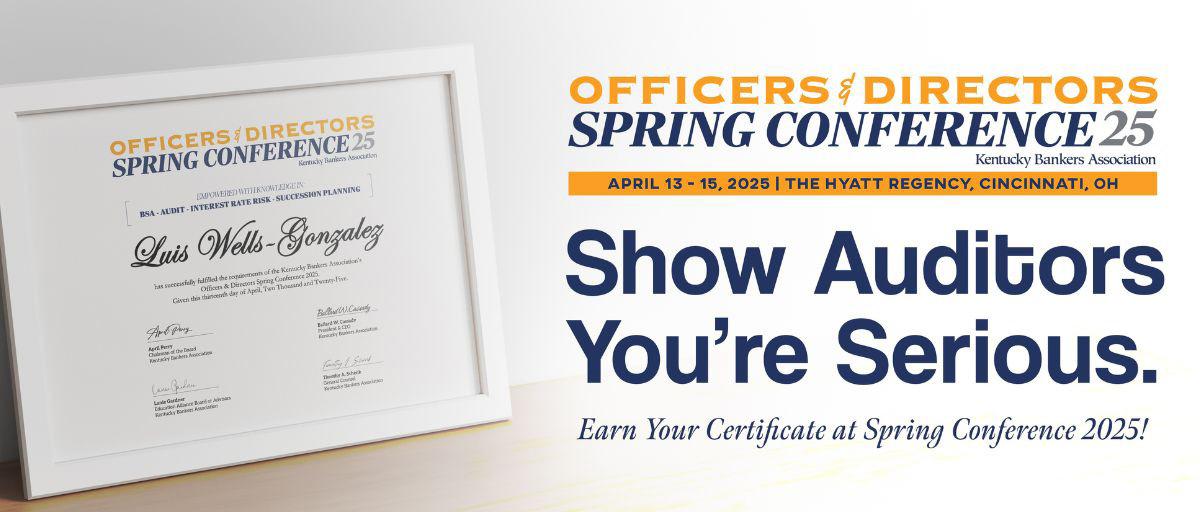


The KBA Spring Conference 2025 isn’t just for board members—it’s a must-attend event for bank officers who want to stay ahead of regulatory shifts, strengthen leadership skills, and connect with peers facing the same challenges. All that to say, this is one Spring Conference you’re not going to want to miss! But in case you needed even more reasons...

Your board’s decisions will define the future of your bank. “ ”
1. Stay Ahead of Federal Changes
Hear directly from regulators about what’s coming next, so you can prepare your institution before changes take effect.
2. Strengthen Board Communication
Understand what your board needs to know and how to provide the right information at the right time.
3. Expand Your Network
The best takeaways often come from conversations outside the sessions. Build lasting connections with fellow bankers and board members.
4. Earn Your Credentials
Attendees will receive 9.5 CRCM and 6.75 CERP credits, plus a compliance certificate to demonstrate their commitment to staying compliant.
5. Sharpen Your Risk Management Skills
Improve your approach to enterprisewide risk management and gain a clearer understanding of regulatory expectations.

Make the most of your KBA Spring Conference experience by staying at the Hyatt Regency Cincinnati, the official conference hotel. Located in the heart of downtown, the Hyatt offers modern accommodations, convenient access to restaurants and attractions, and a seamless experience for conference attendees.
Group Rate: $169 Single/Double per night
Available Dates: April 13-15, 2025
Room Block Expires: March 30, 2025
After March 30: Reservations will be at the hotel’s standard rate
Check-in: 4:00 PM | Check-out: 11:00 AM
Credit Card Required: A card is required at the time of booking
Pet Policy: No pets allowed, except for service animals
Need Assistance? Call the Hyatt Regency Cincinnati at 888-591-1234

Sunday, April 13, 2025, Regency Ballroom
2:00 - 3:00 PM
Registration & Refreshments with Exhibitors
3:00 - 4:00 PM
Why Is Training your Board Important?: Allen North, Federal Reserve Bank of St. Louis
4:00 - 5:00 PM
BSA Principles: Latisha Barnes, Federal Reserve
5:00 - 6:30 PM
Cocktail Reception, Sungarden Room
Dinner on Your Own
Monday, April 14, 2025, Regency Ballroom
7:00 - 8:00 AM
Breakfast
8:00 - 9:00 AM
ALM Modeling - It’s All About Assumptions : Lynn Charlton, Raymond James
9:00 - 10:00 AM
Audits: What your Board needs to know: Victor Osorio, OCC
10:00 - 10:15 AM Refreshment Break
10:15 - 11:15 AM
Washington Legislative Update: Fireside Chat, Kirsten Sutton, American Bankers Association, and Timothy Schenk, Kentucky Bankers Association
1:00 PM
Golf Tournament, Traditions Golf Club, Hebron, KY
6:00 - 7:00 PM
Reception with Exhibitors
7:00 - 9:00 PM
Dinner with Dessert Reception
View KBASpringconference.com for details.
Tuesday, April 15, 2025, Regency Ballroom
7:00 - 8:00 AM Breakfast
8:00 - 9:00 AM
Appealing an Audit: Fireside Chat, Teresa Sabanty, FDIC, and Ballard Cassady, Jr., Kentucky Bankers Association
9:00 - 10:15 AM
What Makes a Successful Succession, Holly Rieser, Federal Reserve Bank of St. Louis
10:15 - 10:30 AM Refreshment Break
10:30 - 11:15 AM
BSA: Expectations of the Board: Fireside Chat, Kristyn Ross, FDIC, and Jessica Southworth, Kentucky Bankers Association
11:15 - 12:15 PM
Leadership, Excellence and Resilience: Fireside Chat, Mitch Barnhart, University of Kentucky, and Ballard Cassady, Jr., Kentucky Bankers Association
CFO Forum & Lunch, Bluegrass Room
12:15 - 1:00 PM Lunch
1:00 - 1:45 PM
CECL Model Validation Expectations: Mike Koupal, Elliott Davis
1:45 - 2:15 PM
State of Liquidity Across the Commonwealth: Brad Johnson, Kentucky Department of Financial Institutions
2:15 - 3:00 PM
Accounting Standard Updates for 2025 and Beyond: Eric Hanson, Clark Schaefer Hackett
3:00 - 3:30 PM Break and Networking
3:30 - 4:15 PM
Navigating the Legislative Landscape: Tax Update for Bank CFOs: Kathy Herbig, Cherry Bekaert
4:15 - 5:00 PM
Balance Sheet Strategies for 2025 and Beyond: Panel

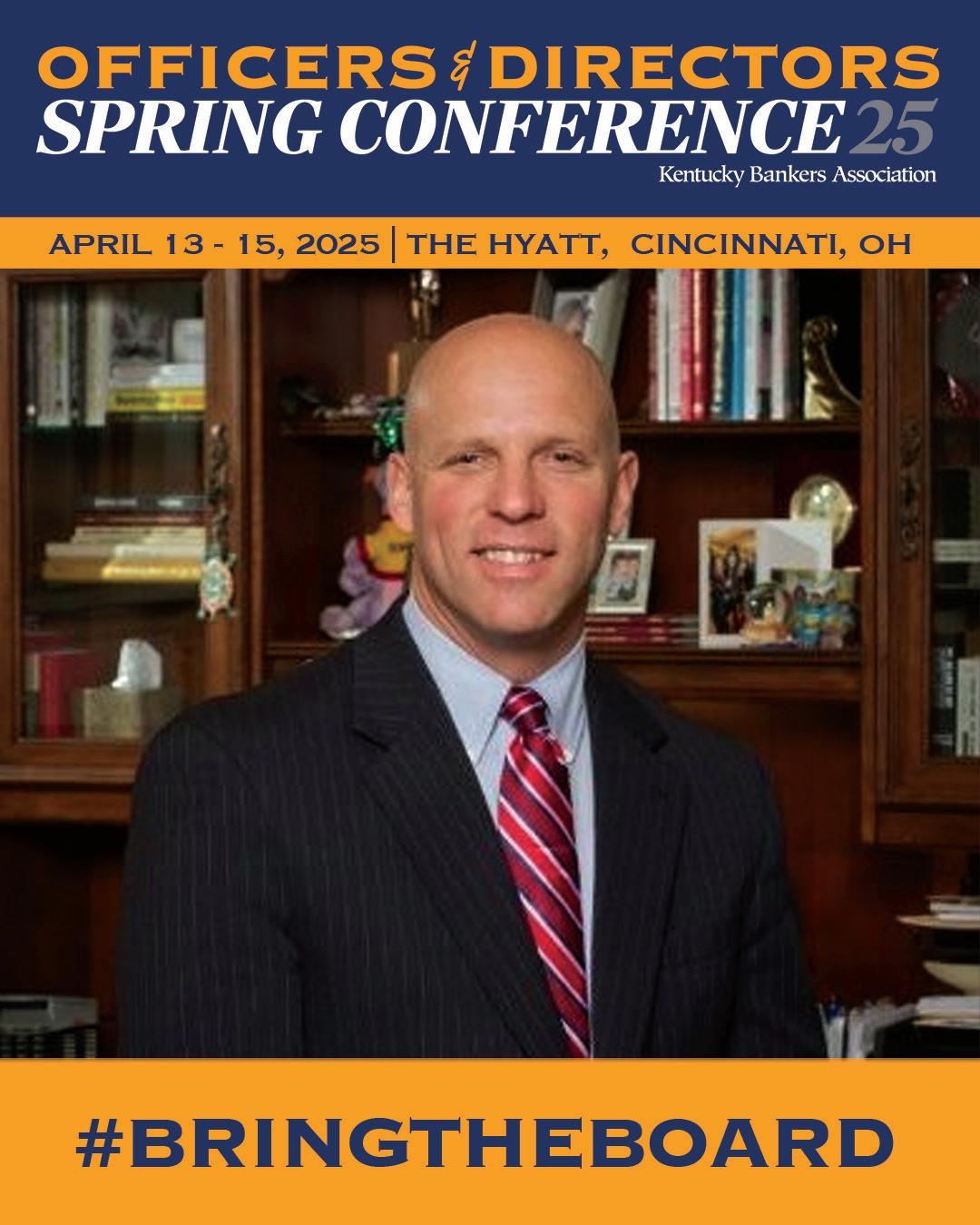
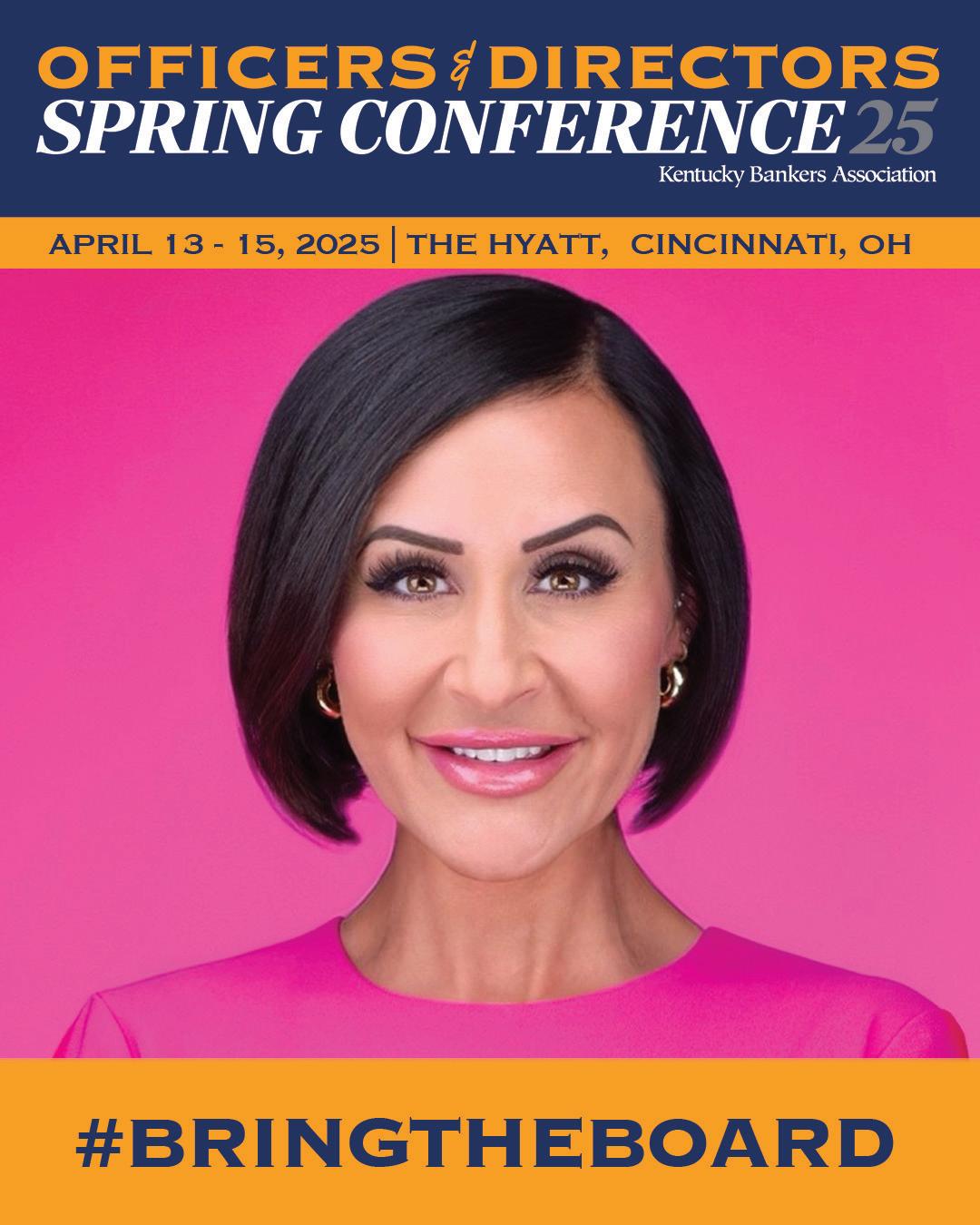

For our complete course catalog and registration info, please visit www.kybanks.com!
April 2, 2025
$395
UnifiedTechnologiesTrainingRoom 11500BlankenbakerAccessDrive,Louisville,KY
This seminar is tailored for internal bank members responsible for reviewing or conducting commercial evaluations. This course provides a robust framework for mastering the intricacies of property evaluation. Participants will gain the skills to accurately identify and characterize the subject property, ensuring precise and relevant evaluations; take a deep dive into the world of leases, exploring key terminologies and various lease types, and apply concepts learned to a practical, real-world scenario with an in-depth case study of an office building.
April 13 - 15, 2025
$695
HyattRegency 151WestFifthStreet,Cincinnati,OH
A game-changer for your Board of Directors. This year’s Spring Conference delivers essential compliance training, equipping your board to meet today’s regulatory demands with confidence. Directors will gain expertise in BSA, AML, and succession planning, earning a KBA Certificate of Completion. CEOs and senior management will explore succession planning, interest rate risks, and audit, while compliance professionals tackle BSA principles, audit scope, and regulatory updates. Give your leadership the knowledge they need—and the credentials to prove it. Visit us at kbaspringconference.com for more info.
Don’t forget about the CFO Forum at Spring Conference!
April 15 - 17, 2025
$975
UnifiedTechnologiesTrainingRoom 11500BlankenbakerAccessDrive,Louisville,KY
Once a lending decision is made, the next step is documentation and closing. This three-day course covers the essential requirements for securing the bank’s position on consumer and commercial loans. Participants will learn the five-step loan documentation process— identifying the borrower, documenting collateral, evidencing the debt, attaching collateral, and perfecting the security interest— along with key compliance requirements under Regulations B and Z. The program also provides a deep dive into commercial loan documentation, including the purpose of each document, the loan closing process, and the rules for perfecting security interests under Article 9 of the UCC and beyond.
May 5 - 8, 2025
$1,045
UnifiedTechnologiesTrainingRoom 11500BlankenbakerAccessDrive,Louisville,KY
This program introduces the consumer lending process from initial application to closing and documentation. Consumer lending school is comprised of seven sessions over four days and encompasses a thorough understanding of consumer lending regulations and the consumer credit policy, the application process, investigating and evaluating consumer loan applications to arrive at the decisionmaking process, underwriting small business borrowers, consumer loan documentation, and lending to special customers. Participants will learn the “TION” method of consumer lending and explore methodologies to thoroughly accomplish successful consumer underwriting through both lectures and case studies.
May 12 - 16, 2025
EarlyBirdRegistration$2,195
PricingafterApril7$2,495
Eachadditionalattendee$2,095
DoubleTreeSuites,2601RichmondRoad,Lexington,KY
Compliance conference dives into regulatory compliance requirements. Knowledgeable and nationally recognized presenters discuss trending deposit, lending, and compliance risk management topics that are relevant to compliance experts! Hear from our regulatory panel representatives on recent findings and what’s on the horizon along with networking with your peers and share experiences. Compliance gurus will address attendees’ issues and every day concerns.
May 21, 2025
$395
KentuckySocietyofCPAs
1735AlliantAvenue,Louisville,KY
This seminar strengthens credit quality and risk management through effective loan review. Learn regulatory expectations, structuring reviews, portfolio risk analysis, debt servicing capacity, and reporting findings. Explore handling sensitive reviews, problem loans, restructuring, and recovery. Gain insights to enhance loan review, support strategic credit risk management, and ensure compliance with evolving regulatory standards.
June 1 - 6, 2025
Year1$1,850
Year2$1,975
GriffinGate,1800NewtownPike,Lexington,KY
The General Banking School (GBS) is a two-year program for bankers ready for advanced training. It bridges concepts and real-world application, equipping professionals with skills for career growth and national graduate banking programs. The curriculum includes classroom sessions and BankExec, a hands-on bank management simulation. Between years, attendees complete Intersession Exercises, applying research to real banking challenges.
June 18, 2025
$395
UnifiedTechnologiesTrainingRoom 11500BlankenbakerAccessDrive,Louisville,KY
This five-part security seminar, led by Barry Thompson, equips employees with the knowledge to protect your institution. Sessions cover Crime Prevention through Environmental Design, Security Demystified, Focus Groups and Case Studies, Adapting to Emerging Technologies, and Conducting a Physical Security Review Assessment. Participants will explore cost-effective facility safety improvements, regulatory responsibilities, and best practices for camera placement, alarm activation, and time locks. Case studies emphasize recognizing suspicious activity, while interactive discussions address security challenges with emerging technologies. The seminar concludes with a step-by-step guide to conducting an annual security review, ensuring institutions remain prepared and compliant.
June 25, 2025 - WKUKnicelyConferenceCenter, BowlingGreen,KY
June 26, 2025 - HyattRegencyDowntown,Lexington, KY
$180firstperson
$165foreachadditionalregistration
Join this exclusive forum to hear directly from regulators as they discuss hot topics, examination priorities, and future regulatory expectations. This panel presentation offers a unique opportunity to address your questions and concerns while gaining insights into areas of intense review from both a safety and soundness and compliance perspective. Regulatory agencies in attendance include the Office of the Comptroller of the Currency (OCC), Federal Deposit Insurance Corporation (FDIC), Federal Reserve Bank (Fed), and the Kentucky Department of Financial Institutions (DFI).


With over $530 million in loans funded to date and more than 7,000 affordable units built, HOPE has united bankers and developers to make impactful projects a reality. From historic preservation at Gateway on Broadway to modern family living at Richwood Bend Apartments, HOPE is transforming communities across the region. Learn how you can join this mission to build a brighter future at hopeofthemidwest.com.





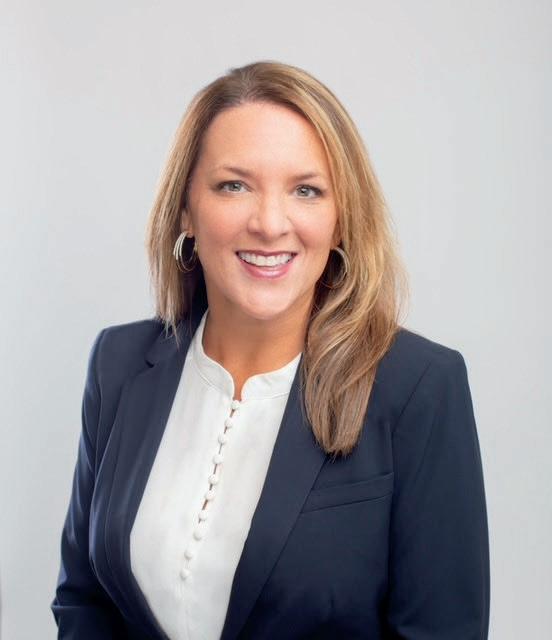
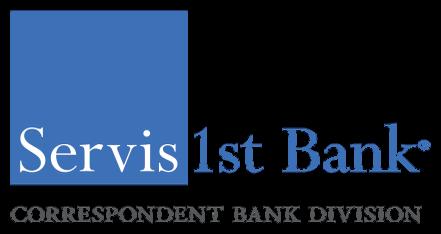





Dormakaba Safe Locks, USA, Lexington, KY: Dormakaba USA Inc. is the largest provider of safe locks globally for financial institutions. Their locks can be found on ATMs (Cencon), inside your bank branches (LA GARD, Auditcon, Axessor). Contact: Caitlin Bradshaw, Vice President of Sales, Safe Locks, Americas
Midwest Security Services, Inc., Louisville, KY: Security Integrator – installation and service of security systems (across control, video surveillance, intrusion detection, intercom systems, fire alarm systems). Contact: Mark Miller, General Manager
Wysh, Brooklyn, NY: Wysh is a forward-thinking insurance carrier, which has an innovative deposit benefit known as Life Benefit. This product revolutionizes financial institutions by seamlessly embedding a micro-life insurance benefit directly on top of deposit accounts. Life Benefit helps financial institutions grow, retain, and differentiate their deposit offering. Contact: Kseniya Zaslavskaya, Business Development Associate Want to learn more about KBA Products & Services? Check out our Vendor Viewpoint Podcast, hosted each month by KBA Products & Services Director Selina Parrish! Use the QR code to tune in!


Imagine a wealth of data carefully curated to improve your banks performance where it’s needed most. A one stop, comprehensive analysis of benchmarks that move the needle. The Bank Performance Report is a state by state quarterly publication proven to transform the way you do business.

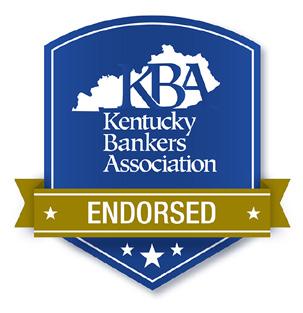
Third-party vendors play a crucial role in the banking industry as financial institutions and technology evolve to meet consumers' ever- changing needs. However, without a shared commitment to business continuity, vendor relationships can falter, potentially impacting operations, compliance, and customer trust.
In 2023, the Office of the Comptroller of the Currency (OCC), Federal Deposit Insurance Corporation (FDIC), and the Federal Reserve introduced updated vendor management requirements, emphasizing the critical nature of robust vendor risk management practice s.
To sustain compliant and effective vendor relationships, banks should proactively identify potential red flags and address them early, mitigating risks before they escalate into larger challenges.
Banks’ vendor relationships look different based on their needs and the services and products the vendor offers, but there are some common challenges most financial institutions face in third -party relationships.
Reluctance
Perhaps the most common red flag banks and other financial institutions face in vendor relationships is a lack of information. Vendors should willingly share business continuity plans, which detail how the vendor will continue to deliver essential products and services amid challenges, and disaster recovery plans, which cover how a vendor will regain critical systems and resume normal operations following an unforeseen event.
If a vendor hesitates to disclose how they protect critical systems, it may indicate potential deficiencies or issues they are trying to hide. In contrast, vendors that are open about their practices generally demonstrate strong security measures and commi tment to maintaining operations during disruptions. For example, if your vendor talks about investing in their failover solutions, they are not only dedicated to protecting data and fulfilling compliance responsibilities they want you, the financial institution, to know they do.
Some vendors are also reluctant to share essential documents. Examples of documents your institution can (and should) request include:

by Svitlana Keeney Compliance Officer Compliance Hub
While some believe that fiduciary trust services and wealth management services are often thought to overlap, they are based on distinct differences and serve different purposes. To elaborate, wealth management services are designed to address a client’s all-encompassing financial health, including aspects such as retirement planning, tax efficient strategies, asset allocation, risk management, and investment advice. It targets financial growth and preservation of wealth over the long term while adapting to the client’s changing financial needs.
On the other hand, fiduciary trust services are much narrower in focus, concentrating on asset management and placement within a legal trust. Fiduciary trust services are tailored to safeguard assets, maintain the integrity of the trust, and ensure that the intent of the grantor is fulfilled with a clear focus on long-term responsibility. Trust management ensures that the assets are adequately administered, the terms of the trust are adhered to, and the distribution to beneficiaries occurs as intended. While wealth management addresses a wider more complex scope of financial planning, fiduciary trust services are more of a specialized mechanism within that broader framework.
A large Financial Institution (FI) may establish a wealth management group consisting of several interlocking divisions, branches, subsidiaries, and affiliates that provide a broad range of tailored financial products and services on a greater scale. A small FI, such as a community bank, may simply operate a separate “Trust” division or department that provides traditional fiduciary services and may also provide access to retail brokerage services through an affiliated or unaffiliated third-party firm located within the bank’s branch network.
Let’s take a closer look at the basic principles of each to clarify the differences:
Fiduciary Trust Services:
• Duty of Care: A fiduciary is legally obligated to act in the best interests of their client. This means prioritizing the client’s needs over their own, avoiding conflicts of interest, and ensuring all decisions are made with the utmost care and diligence.
• Legal Responsibility: Fiduciary duty is a legal standard. For example, trustees, executors, and advisors in fiduciary roles are legally bound to act in a way that benefits the trust or the individual they serve.
• Focus on Long-Term Interests: Fiduciaries are often involved in managing assets that are held in trust, with a focus on preserving and growing the assets for the beneficiaries over a lengthy period.
Wealth Management Services:








• Conservative Approach: Given the legal responsibilities and duty to protect the client’s interests, fiduciary trust services tend to take a more conservative approach to investing and asset management.
• Comprehensive Financial Planning: Services are more holistic in nature, often encompassing not just investment management, but also tax planning, estate planning, retirement planning, and even lifestyle management.
• Client-Centered Approach: Wealth managers typically focus on understanding the client’s overall financial situation and goals, tailoring solutions to help clients achieve those objectives. While wealth managers can be fiduciaries, they do not always operate under the same strict legal framework as fiduciaries.
• Investment Focus: Services often emphasize investment management, with the goal of maximizing returns based on the client’s risk tolerance and financial objectives.
• Broader Service Scope: Wealth managers often provide a range of services beyond investment, such as business succession planning, philanthropic strategies, and asset protection strategies.
Key Differences:
• Fiduciary Duty: Fiduciary trust services have a legal obligation to always act in the client’s best interest, while wealth management services may not always operate under the same legal obligation.
• Service Scope: Fiduciary services focus more narrowly on managing assets with a primary duty to preserve and grow the client’s assets, whereas wealth management involves broader, more personalized financial planning.
• Approach to Risk: Fiduciaries are generally more conservative in their investment strategies because of the legal responsibility to protect and preserve trust assets. Wealth managers may adopt a more dynamic and flexible approach depending on the client’s goals and risk tolerance.
While both fiduciary trust services and wealth management services aim to grow and protect wealth, their focus and legal obligations differentiate the two. Fiduciary trust services are more narrowly focused on a legal duty to act in the client’s best interests, whereas wealth management offers a broader set of financial services, potentially without the same level of fiduciary obligation.
Fiduciary trust services may include:
• Investment management for trusts and estates and for charitable trust services.
• Tax reporting, trust structuring and documentation, and record-keeping.
• Guardian and conservatorship services.
• Corporate trust services.
• Fiduciary advice and guidance, as well as asset protection strategies.
• Trustee services (acting as trustee for individuals or organizations).
• Distribution of assets in accordance with the trust document or estate plan.
• Handling complex estate planning.
Wealth management services are designed to address the customers’ financial needs that come with substantial wealth. These services are often strategically customized to help ensure that each aspect of the customer’s financial situation is addressed in an integrated way. The key components may include:
• Banking and Lending Specialized Products and Services (tailored savings accounts, premium credit cards, and specialized loan products).
• Trust Services (Estate Planning, Trust Administration, and Fiduciary Services).
• Investment Management Services (investment advice, asset allocation, and alternative investments strategies).
• Portfolio Management
Compliance and Risk Management Considerations:
Fiduciary and wealth management activities are highly regulated. Therefore, it is essential to establish a comprehensive compliance framework that can help mitigate risks related to conflicts of interest, self-dealing, and other unethical practices. When developing an effective compliance framework, several key elements and considerations must be incorporated to ensure adherence to regulatory standards and foster ethical practices. Here are some key components:
1. Clear Governance Structure:
• Establish oversight committees to monitor fiduciary activities and ensure compliance with all regulatory and ethical guidelines.
• Designate compliance officers who are responsible for enforcing compliance policies and procedures and ensuring ongoing staff training.
2. Written Policies and Procedures:
• Code of Ethics: Develop and communicate a code of ethics that outlines the fiduciary responsibilities, emphasizing the duty to
act in clients’ best interests.
• Conflict of Interest Policies: Identify potential conflicts and establish processes for disclosure, management, and mitigation of conflicts. Ensure that employees understand their duty to avoid self-dealing or transactions that benefit themselves at the expense of clients.
• Clear Disclosure Requirements: Policies should mandate full disclosure of any potential conflicts of interest, so clients are aware of any situation where the bank or its employees may have competing interests. This transparency helps maintain trust and accountability.
3. Client Disclosure and Transparency:
• Clearly communicate all fees, costs, and compensation arrangements. Ensure clients are aware of how fees are structured, including any performance-based fees, commissions, or compensation arrangements that could create conflicts of interest.
• Disclose any business relationships or financial interests that could influence the advice provided to clients.
4. Training and Education:
• Regular training for employees and advisers on fiduciary duties, ethical practices, regulatory updates, and how to handle conflicts of interest.
• A FI’s employees should be well-trained on compliance policies, ethical standards, and legal obligations. Clear communication about ethical behavior and conflicts of interest help prevent breaches of trust and unethical behavior.
5. Risk Management:
• Effective internal controls are critical to mitigating risks. This includes ensuring compliance with regulations and conducting regular audits.
• Implement procedures for identifying and managing financial and reputational risks related to unethical behavior, fraud, and non-compliance.
• Regularly review and assess internal controls and risk management procedures, adjusting them to reflect new regulations or emerging risks.
• Establishing physical and operational firewalls between departments (e.g., trading, research, and compliance) can prevent the improper sharing of sensitive information that might influence decision-making in favor of the bank rather than the client.
6. Monitoring and Reporting:
• Establish regular audit mechanisms to ensure adherence to policies and procedures. Regular audits and assessments by independent parties (like internal or external auditors) can help ensure compliance with the policies and reveal any instances where conflicts of interest may arise.
• Implement automated systems for tracking transactions, conflicts, and compliance breaches.
• Set up a whistleblower policy and confidential reporting channels to allow employees to report unethical behavior without fear of retaliation.
7. Third-Party Due Diligence:
• Implement a robust process for conducting due diligence on external partners, custodians, or other service providers to ensure they also comply with fiduciary standards and regulations.
• Establish written agreements with third parties that clearly outline their fiduciary responsibilities and compliance obligations.
8. Regulatory Compliance:
• Having a team of knowledgeable professionals may be important in navigating the complex landscape of regulations governing investment management, such as securities laws, anti-money laundering (AML) regulations, and fiduciary responsibilities.
• Stay updated on local and international laws and regulations.
• Ensure that compliance efforts evolve as new regulatory changes or industry standards emerge.
9. Performance and Client Reporting:
• Maintain transparency and accuracy in reporting client portfolio performance, avoiding misleading statements or omissions that could mislead clients.
• Provide regular, detailed updates on portfolio performance, any changes in strategy, and associated risks.
10. Ethical Culture:
• Cultivate an organizational culture that prioritizes integrity, client interests, and ethical conduct at all levels. Encourage ethical decision-making and accountability in all staff.
• The FI needs to ensure that compensation structures for financial advisors (including bonuses or performance incentives) are aligned with client outcomes. Tying these together rather than simply the bank’s financial performance can reduce the temptation to prioritize bank interests.
An effective compliance program must be dynamic and proactive in addressing potential risks and ensuring adherence to relevant laws and regulations. It should include a robust framework for monitoring activities, detecting potential violations, and addressing issues promptly. This involves internal audits, regular risk assessments, and a clear process for reporting and resolving compliance issues.Non-compliance with legal standards can have far-reaching consequences for the FIs, including regulatory sanctions, civil and criminal penalties, and damage to the FI’s reputation.
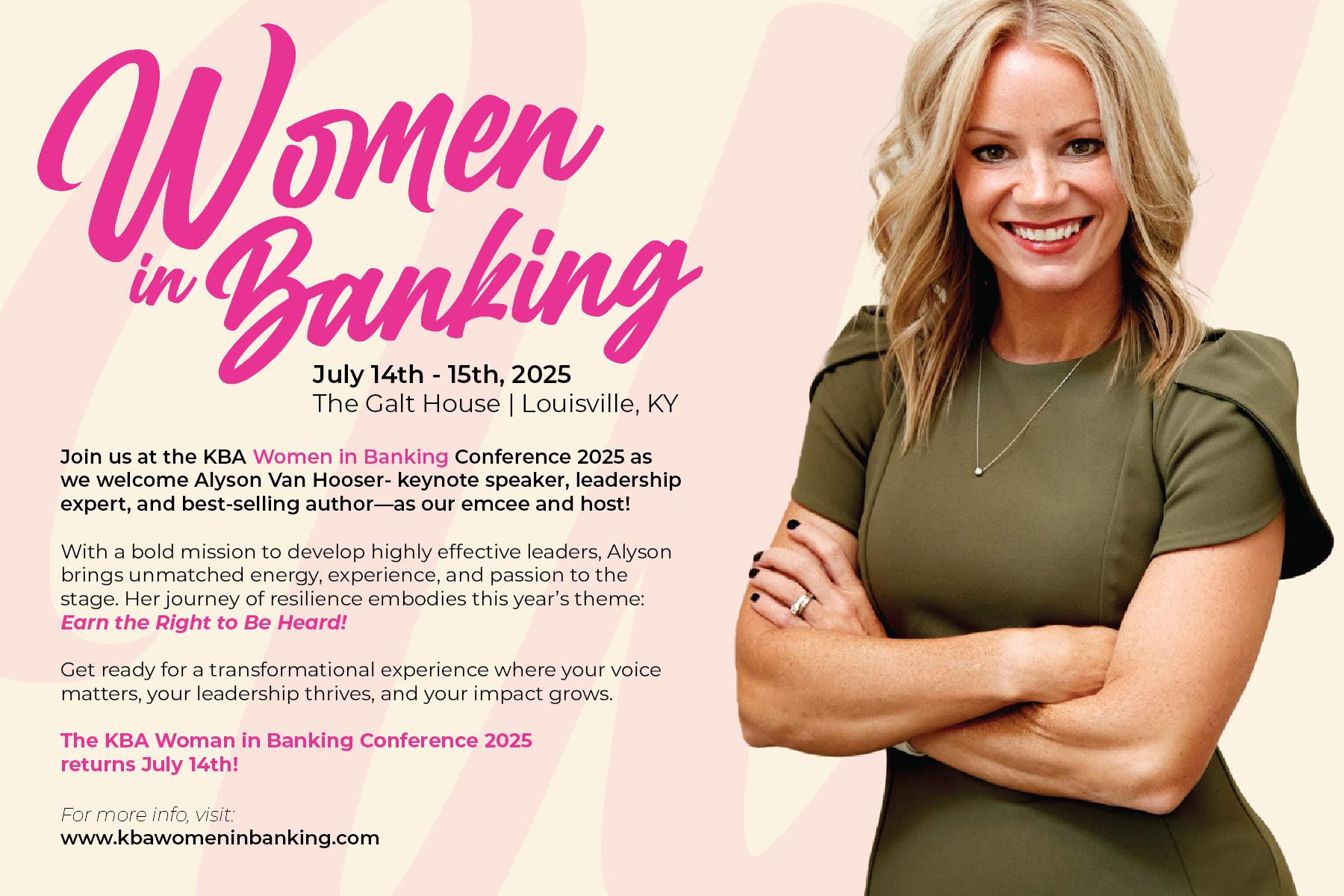

by Brad Giddens Director of Sales – FID, Integris
With a new administration coming in, 2025 promises to be a year of change. But will it significantly impact banking regulation and your bank’s cybersecurity? No one has a crystal ball, of course, but recent global outlooks for the banking industry seem to point to two conclusions:
• Banking regulation will likely loosen overall as our new president seeks to fulfill his campaign promise to lower government oversight of businesses.
• Banking cybersecurity regulation, however, is likely to tighten as the government seeks ways to strengthen national security in the money system.
Given this, banks will spend more money in 2025 to harden their cybersecurity defenses and mature their overall operations. Our recent report reveals this sentiment: 86% of the 1,000 bank executives we interviewed said they were increasing their IT budget by more than 10% next year.
#1—Tighten up your third-party vendor management.
If the CrowdStrike outage taught us anything, it’s that third-party vendors have the power to upend your business without warning. A simple failed update to CrowdStrike’s cybersecurity platform managed to snarl business operations for hours or even days at some of America’s largest banks, including Chase, Bank of America, US Bank, and more, costing millions in lost transactions.
Many banks have agreements with vendors about what data they’ll have access to and the overall rules of engagement. But have you thought about:
• Written agreements in your procurement process that discuss access to data, your physical locations, and physical documents?
• Written protocols and statement of work that outline your
vendor relationship for your employees and your vendor?
• Automated tools that track compliance metrics for your vendors and monitor their performance?
• Incident response and disaster recovery plans that kick into action if your vendor suddenly goes offline? How would your system backup in the event your vendor went dark?
Backing up operations around your third-party vendors could be an added expense that pays dividends over time.
#2— Rethink your data classification.
As more banks experiment with AI platforms like Copilot for M365, or data analysis tools, the need for classifying levels of access to documents and data sets has become too important to ignore. Many countries worldwide are calling for businesses to tighten up classifications around their documents as a foil to nation-state hackers or undue influence from foreign governments. As cybersecurity rules tighten around data classification, and you’re looking to reclassify, ask yourself these questions:
• How vulnerable would we be if this document fell victim to malicious hacker activity?
• Would anyone who now has access to this document be able to exert undue influence over us or others with this information?
• Would foreign governments gain an advantage from having this information?
Let this be an additional consideration for your classification levels. Examine your protocols and get them in writing for your employees. Make document safety training a new and expanded part of your security awareness training.
#3—Tighten up your physical security
When did you last review the physical security protocols for your branches, office spaces, and physical file storage? Ask yourself:
• Who has access to these spaces? How do we vet them? Is it time to upgrade the way we monitor passwords and access?
• Can we eliminate the need for physical files? Can we improve the isolation and disposal of sensitive printed documents?
• Have we fully considered what climate risks might affect our branches and offices? Has the risk increased in your area, and how will that impact your protections? Is it time to expand our insurance to include flood coverage? Do we have emergency operations plans to cover a sudden hurricane, earthquake, tornado, or mudslide? Is our cyber risk insurance well positioned to cover our IT operations in these emergencies, or do we need to increase the size and scope of our policy?
Once you’ve answered these questions and upgraded your protocols and written procedures, arrange for a technical inspection of all your facilities each year to ensure adherence.
#4—Update Your Backup, Disaster Recovery, and Business Continuity Plan.
If it’s been a year or two since you’ve reviewed your Disaster Recovery Procedures within your Business Continuity Plan (BCP), you might be overdue for an upgrade. Ask yourself:
• Have we had any growth or additional traffic that our BCP does not fully cover?
• Do we have secondary, offsite backups?
• How well do our current backup strategies cover our cloud services? Do we need an additional cloud backup service to protect our cloud platforms? If your cloud services go down, we highly recommend this.
• Is your BCP plan tuned to your current RTO-recovery time objective (the amount of time you can go before you must have a backup) and your RPO-recovery point objective (the amount of data you can afford to lose before you must have a backup)?
Answer these questions, and you’ll be well on your way to your bank’s freshly upgraded BCP plan. According to our survey, banks aren’t skimping on this. Most respondents listed cloud backup as a key investment area for them this year.
#5—Get Your AI Fair Usage Policies in Writing.
If you don’t have an AI policy, you need one—even if you’re not currently adding AI tools to your software kits. You can’t afford to wait. New AI-driven tools and features are being added to familiar platforms like M365, and employees and customers are bringing AI-enabled phones and personal devices into your bank daily.
Banks have a lot to think about regarding AI, which we’ve
discussed in this recent blog. But first and foremost, you need a clear, comprehensive written policy around the safe usage of AI. Once you’ve got it, make sure to work with your HR and communications departments to get those documents signed and understood by employees. Need help writing it? Our free downloadable AI Policy is a great place to start.
#6—Upgrade
Every year, regulators will look closer at your risk management platforms. Now is a good time to make sure you’ve left no detail unexamined. The new year is a great time to think about what you could improve and refine, such as:
• Vulnerability scans—Are you truly covering your endpoints well? We recommend upgrading from a simple SIEM (Security Incident and Event Monitoring) system to a fully AI-powered XDR (Extended Detection and Response) system, which can capture, isolate, and remediate threats in a much more holistic and immediate way.
• Controls testing—When was the last time you conducted a full penetration test? It’s time to create a schedule and protocol for this in writing and a process for any needed remediations.
• Better documentation—If your risk management tools and vulnerability scanners aren’t kicking out good monitoring and remediation reports, it’s time to get ones that do. Regulators will be looking hard at the documentation you generate here. Find tools that make the job easy for you.


